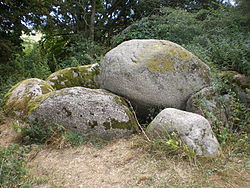Gold bush
| Gold bush Great stone grave Altensien | ||
|---|---|---|
|
|
||
| Coordinates | 54 ° 21 '32.6 " N , 13 ° 40' 54" E | |
| place | Altensien , Mecklenburg-Western Pomerania , Germany | |
| Emergence | 3500 to 2800 BC Chr. | |
| Sprockhoff no. | 508 | |
The gold bush is a large dolmen , a prehistoric burial complex . It lies between Altensien and Moritzdorf on the Baltic island of Rügen . The large stone grave with the Sprockhoff no. 508 was created between 3500 and 2800 BC. BC in the Neolithic as a megalithic system of the funnel beaker culture (TBK). “Neolithic monuments are an expression of the culture and ideology of Neolithic societies. Their origin and function are considered to be the hallmarks of social development ”.
construction
The approximately 3.5 m long, 2.4 m wide and 1.2 m high burial chamber has side walls made of 7 large and one small bearing stone. Originally there were three capstones on the bearing stones, one of which has been preserved. There are 27 shallow depressions, so-called bowls , on the capstone . The burial chamber, which ran in an east-west direction, was previously completely covered by a hill and only by a narrow corridor that opens into the narrow west side, which otherwise only occurs once in Mecklenburg-Western Pomerania . The corridor consists of red sandstone slabs . The narrow side of the chamber opposite the passage is formed by a single large stone. In comparable systems, there is often a stone border of the entire system ( giant bed ). There is no comparable item in the Goldbusch, but it may have been there. It is possible that the facility was originally located under a mound of earth covered with rolling stones .
history
The grave complex was built in the Neolithic by the peasant population of the funnel beaker culture and was used for several centuries. The dead are said to have been laid out in the open for long periods of time. The bones were placed in the chamber with the grave goods. A large number of similar structures existed in close proximity to the Goldbusch. On Hagenow's map from 1829, 43 large stone graves are still drawn in the little more than two kilometers long area between Altensien and Seedorf . Of this, only the gold bush located in the immediate vicinity of the shore of the Selliner See was partially preserved.
Result of the excavation
In 1969, an excavation led by Ewald Schuldt took place at Goldbusch. The burial chamber was already badly damaged by this time. It was found that the bearing stones of the chamber were not sunk into the ground, but only lay on top and are fixed with stone wedges and clay, which indicates a late development as the early systems were partly built very deep in the ground. The capstone had slipped into the burial chamber. Only remnants of the original grave goods could be found. Besides arrowheads and six hatchets from flint one were gouge , various pieces of pottery and two decorated pottery found.
See also
literature
- Friedrich von Hagenow : Special chart of the island of Rügen. Designed according to the latest measurements using all existing land maps. Lithographic Institute of the General Staff, Berlin 1829.
- Luise Lorenz: Ceramic lifetimes and the useful life of northeast German megalithic graves. In: Martin Hinz, Johannes Müller (eds.): Settlement, trench works, large stone grave. Studies on the society, economy and environment of the funnel cup groups in northern Central Europe (= early monumentality and social differentiation. Volume 2). Rudolf Habelt Verlag, Bonn 2012, ISBN 978-3774938137 , pp. 61-86 ( online ).
- Ingrid Schmidt: megalithic grave and sacrificial stone. Soil monuments on the island of Rügen. Hinstorff Verlag, Rostock 2001, ISBN 3-356-00917-6 , pp. 27-28.
- Ewald Schuldt : The large dolmen of Altensien, Rügen district. In: Ground monument maintenance in Mecklenburg. Yearbook 1971. 1972, pp. 133-141.
- Ewald Schuldt: The Mecklenburg megalithic graves. Research on their architecture and function. VEB Deutscher Verlag der Wissenschaften, Berlin 1972.
- Ernst Sprockhoff : Atlas of the megalithic tombs of Germany. Part 2: Mecklenburg - Brandenburg - Pomerania. Rudolf Habelt Verlag, Bonn 1967, p. 73.
Web links
- The Megalithic Portal: Altensien Goldbusch
- grosssteingraeber.de: Altensien
- strahlen.org: Altensien
- cruptorix.nl: Goldbusch
Individual evidence
- ^ Johannes Müller : Neolithic Monuments and Neolithic Societies. In: Hans-Jürgen Beier et al. (Ed.) Neolithic monuments and neolithic societies (= Varia neolithica 6, 2009 = contributions to the prehistory and early history of Central Europe 56). Beier & Beran, Langenweissbach 2009, ISBN 978-3-941171-28-2 , pp. 7–16, here p. 15.


